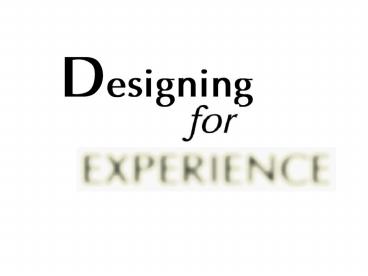Content - PowerPoint PPT Presentation
1 / 20
Title: Content
1
(No Transcript)
2
Content
- Why study Experience?
- Approaches to User-Experience
- HCI and others
- Product-centred
- User-centred
- Interaction-centred
- The wicked problem of Experience
- McCarthy Wright Technology as Experience
- Looking ahead
3
Why is experience important?
- The Experience Economy (Pine Gilmore, 1998)
- Users as consumers (Kuutti, 2001)
- When people started to use the phone as a means
for self-expression, a new concept of the user
was needed a user who besides rationality and
reason has also emotions and needs for pleasure
and self-expression. - 1970s User as a cog in a rational machine the
influence from organization theory - 1980s User as a source of error the influence
from human factors and psychology - 1990s Users as partners in social interaction -
the influence from anthropology and
microsociology - Designing for the full range of human experience
may well be the theme for the next generation of
discourse about software design (Winograd, 1996)
4
(No Transcript)
5
HCI
- THEORETICAL/CONCEPTUAL
- Frameworks analyse UXP
- Pragmatist Philosophy, Literary theory, film,
Psychology - Pragmatist aesthetics
- Somatic marker hypothesis somaesthetics
- Co-experience
- Psych modelling - goals and actions
- Action-Motivation-Context guidelines for design
- Kraseks model of demand-control-support model
METHODS TECHNIQUES design guidelines criteria
for assessing the XP visual appeal using
aesthetics fantasy games to generate emotional
ideas Cue from augmented reality
tangibility Rich interactions Measuring
preference, facial muscles, transcendence
DESIGN CASES Resonance - observing peoples
interactions. Loop iterations. Horror to enhance
fun (via Augmented reality) Tool enabling a
network of people to share stories about daily
experiences
6
others
- INDUSTRIAL DESIGN
- Theoretical/conceptual
- "concentrate on appearances"
- framework to analyse person-product interaction
- categorising, operational, inventive, aesthetic
and social use how people interact with products - product semiotics
- Methods and Techniques
- Learning from augmented reality guide to
designing for rich interactions - fun of use attractive interactions,
customisation, personalisation
MULTIMEDIA Using digital media to represent
inner experiences BUSINESS Methods and
Techniques tools to learn people's XP with
products and expectations engaging storytelling
GAMES design case studies Extending traditional
usability testing on computer games (check users
against designers) LRP experience to inform
design (games) PERVASIVE COMPUTING cafe based
digital design
7
Product-centred approach
Assist designer and non-designers to create
products that evoke compelling experiences
Describe kinds of experiences and issues to be
considered in design and evaluation
Usually lists of topics or criteria used as a
checklist
8
User-centred approach
For designers and developers to understand
users
Integrate knowledge from other disciplines to
understand peoples actions and aspects of
experience that people find relevant when
interacting with a product
9
Interaction-centred approach
Explore the role that products serve in bridging
the gap between designer and user.
A more integrated and holistic approach
10
The wicked problem of experience
Impossible to extricate person from experience
Experience is unique to the individual and on
each occasion
Experience is multi-dimensional
Experience is owned across many disciplines
Experience is potentially arbitrary
11
The wicked problem of experience
Experience is never neutral
Experience is dynamic
Experience transforms
Designing for experience is a wicked problem
12
Approach to felt experience
- some social-theoretical approaches used to
reflect on relationships between people and
technology, put social processes at the centre
and marginalise self and identity, emphasising
the routine and sameness in life. An orientation
toward felt experience emphasises the ways in
which people deal with routine.
...focusing on the routine itself misses out on
the variety of feelings toward the routine and
ways of dealing with it. If we sacrifice the
uncertainties, the anxieties, the clarity and the
insight that we experience when dealing with the
routines of life to a synthesis at the level of
social practices, we close off our
conceptualising to variety, change and
complexity.
13
McCarthy Wright Making sense of Experience
Draw together works by Dewey, Bakhtin and
Boorstin to try to understand experience in order
to help designers and evaluators create
fulfilling interactive experiences.
Irreducible totality of people acting, sensing,
thinking, feeling, and meaning making in a
setting, including their perception and sensation
of their own actions.
14
McCarthy Wright Framework use
An analytical tool to help explain why particular
interactive experiences are satisfying and others
not.
A space within which things can be juxtaposed,
related, separated, coalesced but never isolated.
Useful in design and evaluation without losing
too much of the relational, holistic approach
from where it is derived.
15
McCarthy Wright Framework components
Four aspects as four inter-twined threads making
up a braid.
Experience not engaged as ready-made. Making
sense - reflexive and recursive No experience
without self and object, or subject and object,
interacting reflexively. No implication of linear
or causal relations between these processes
16
M Ws Framework Four threads of experience
17
M Ws Framework sense-making components
18
Testing the Framework
- A practitioner-centred assessment of a user
experience framework (McCarthy, Wright,
Meekison, 2005)
- Used it with practitioners (action research)
undergoing an Internet shopping experience - How they used the framework
- What aspects of experience they felt was missing
- How useful a tool to evaluate Internet shopping
experience
- Limitations
- Difficult to distinguish some sense-making
components - Lacked ability to capture intensity of experience
- A priori introduction
- contemporaneous note taking
- Could contribute to shaping as more reflective
than usual
19
Looking ahead
- Theoretical/Conceptual
- using testing current XP framework with more
users - toward informing theoretical understanding
- to gain insight towards modifying Framework
- into a more usable tool for
- designers to use to guide design
- designers to use to evaluate design
- Methods Techniques
- ways to capture the subjective, rich, felt and
lived experiences described - ways to analyse the captured experience
- Design
- Ways to translate understanding of
user-experience into tangible design outcomes
20
(No Transcript)































